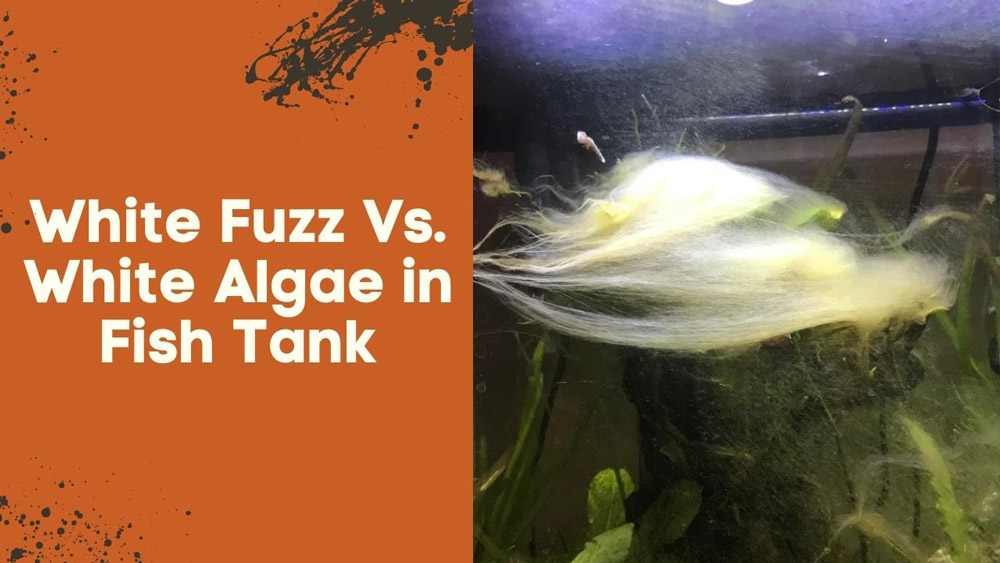If you have a fish tank, there is a good chance that you have experienced some sort of white fuzz. All fish keepers are familiar with the challenges caused by “white fuzz,” a general term used to describe a variety of different species of water mold. The term “water mold” has been commonly used to refer to “fungus,” but it’s actually not inaccurate.
On the other hand, white algae are a fairly common organism in your tank, and it’s generally not a problem. In fact, some aquarists believe that a little bit of algae is good for the tank.
So, what’s the difference between white fuzz Vs. white algae? In this article, we will take a closer look at white fuzz and white algae and discuss the best ways to deal with them.
White Fuzz Vs. White Algae: what’s the difference?
The main difference between white fuzz and “white algae” is that white algae are simple, plant-like, eukaryotic (nucleus-bearing) organisms, while white fuzzy (water mold species) are prokaryotes. The “white” fuzz or Staghorn algae have coarse threads than water molds and take months to grow. Sometimes, the long streamers of white fuzz stuff can appear overnight and disappear in a few days to weeks.
What is the White Fuzzy (Fungus) Stuff in My Fish Tank?
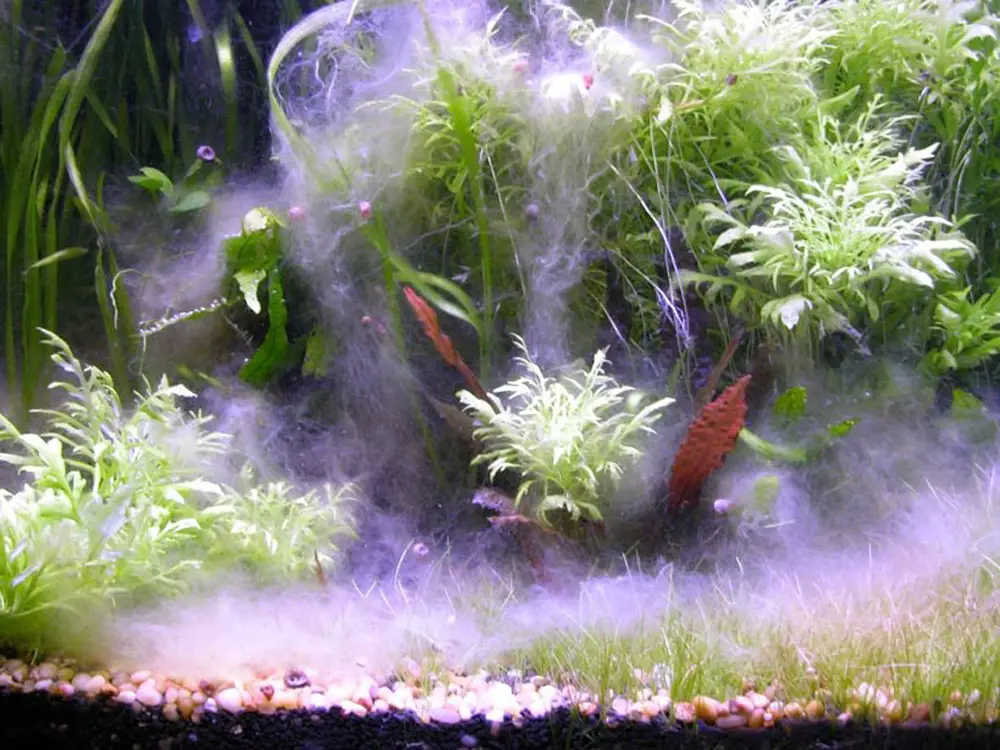
If you see cotton-like white fuzzy stuff in your fish tank, it is most likely not algae but water molds feed on organic matter in your aquarium. The most common is Saprolegnia sp., which often appears as white fuzz on plants, rocks, and other aquarium decorations.
The term “white fuzz” is a general term used to describe a variety of different species of water mold, including fungus, tufts, cotton, white streamers, etc. Most of these white fuzzy growths are species of water mold. It can be dangerous for your fish and must be treated immediately.
The white fuzz will also spread very quickly in your tank. You need to take preventive action and work on treatment options. If you do not treat white fuzz in your aquarium, there’s a chance it could get worse.
The obvious signs of white fuzz are white stringy stuff in your aquarium. Apart from that, there are other signs you can look out for. These signs include:
- White spots on your fish fin or tail
- White cotton attached to the aquarium decoration
- White fuzz on the surface and walls of the aquarium
- White cloudy look in the tank
- White fuzzy stuff growing on tank ornaments
- White fluff floating in the tank
- Tank driftwood has white fuzz on it
What is the water mold?
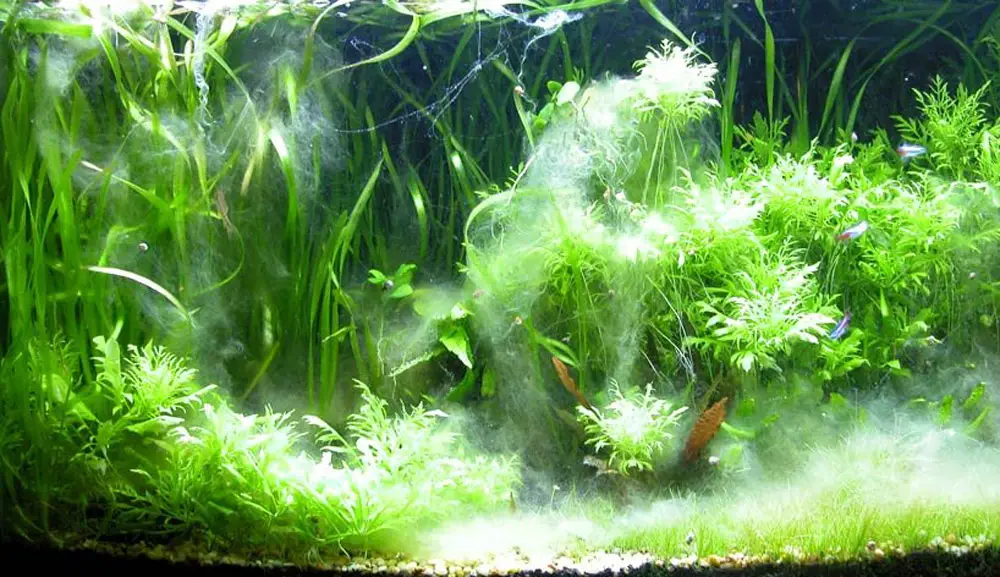
Water mold is a group of filamentous funguslike organisms with about 250 species. The majority of members are found in three genera: Achlya, Leptolegnia, and Saprolegnius. In particular, two species, Saprolegnia diclina, and Saprolegnia parasitica are of major importance in the world as fish pathogens.
Typically, most species are saprotrophic, which obtain their nutrition from dead and decaying organic matter. However, many species are parasitic or pathogenic and cause diseases in certain fishes, plants, and algae.
Water molds are often found in stagnant or slow-moving waters in the wild, such as ponds and lakes. In an aquarium, water molds can enter the tank through contaminated fish food, live plants, or new fish.
In freshwater or saltwater aquariums, the water mold is a harmless but opportunistic pathogen. It’s considered one of the important decomposers in freshwater aquariums and can decompose both plant and animal material.
Water molds also have branched filaments and form spores. They can reproduce both sexually and asexually and are composed of a tube-like vegetative body, mycelia.
It will not attack healthy fish and disappear during the process of tank cycling. However, because of their opportunist and saprotrophic nature, the zoospores will take hold of any dead tissue to inhabit, which includes wounds and injuries on your tropical fish.
Once the water mold takes over the dead tissue, it will start to spread and infect other areas of the fish. If left untreated, the white fuzz can kill your fish.
What Causes White Fuzz in a Fish Tank?
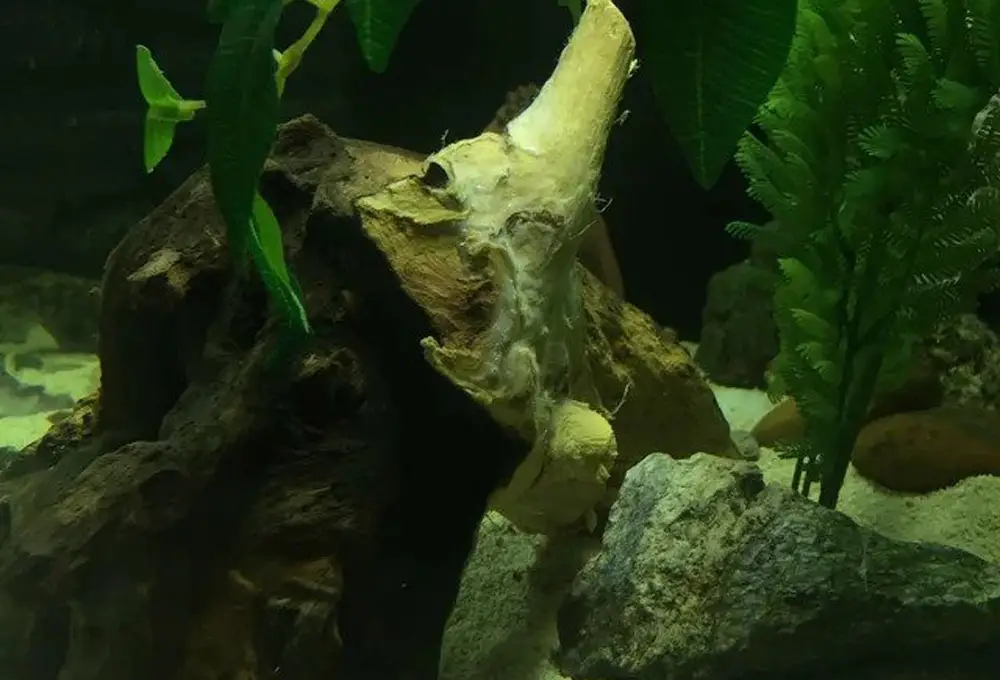
The main reason for white fuzz in your aquarium is the presence of fungus, bacteria, and parasites. The common causes behind the growth of white fuzz are:
- Due to fungal infection: Sometimes, white fuzz may result from a fungal infection. Fungal infections are less common than bacterial infections because your fish tank needs high levels of ammonia and nitrate for fungi to thrive.
- Overfeeding: One of the most common problems that lead to the growth of white fuzz in your aquarium. When you overfeed your fish, the water molds will feast on the excess food and multiply rapidly. Moreover, the uneaten food will also decay and pollute the water, further encouraging the growth of white fuzz.
- Lack of aeration: Lack of aeration in your fish tank can also cause the growth of white fuzz. When there is insufficient aeration, the oxygen levels in the water will drop, and the water molds will start to grow.
- Dirty driftwood or substrates: If you are using dirty driftwood or substrates in your fish tank, it can lead to the growth of white fuzz. The molds and fungus will attach to the surfaces of the wood and grow rapidly.
- Sick or injured fish: If you have a sick or injured fish in your tank, the water mold can easily take advantage of it as a host and start to spread.
- Untreated tap water: If you use tap water that has not been treated, it can also lead to the growth of white fuzz. The chlorine in the water will kill the beneficial bacteria in your aquarium and allow the water molds to take over.
How to get rid of white fuzz (fungus) in aquariums?
Don’t panic if you notice white fuzz growing in your fish tank. That’s completely normal! The best thing you can do is to know the causes so you can prevent white fuzz in the future.
Although almost all aquariums have some white fuzz growing in them, there are ways in which you can get rid of white fuzz in fish tanks. Let’s take a look at some ways to get rid of white fuzz in your aquarium:
- Find out the potential hosts. Take a bit of detective work. Maybe the problem is hiding under an aggressive tropical fish or sharp decor. Remove the problematic source immediately.
- Do large 50%- 95% water changes. Depending on tank size.
- Increase water movement – Water molds thrive in still water, so increasing water movement makes it harder for the fungus to take hold. You can do this by adding more filtration or using an air pump.
- Start a biofilter – this will consume more organic matter and help reduce fungal overgrowth. If you already have a biological filter, don’t clean it out completely, as you’ll lose the good bacteria there.
- Increase the temperature – Also known as “winter kill,” Water molds prefer a colder environment, so increasing the temperature will help to kill it off. Aim for a temperature of around 82 degrees Fahrenheit.
- Don’t overfeed your fish: Usually, 15 minutes of feed is enough for the fish. Otherwise, the leftover becomes food for fungus and bacteria that give rise to cotton colonies.
- Keep an eye on fish activity: If you feel that any of your fish is not swimming well or hiding behind the things, something is wrong with it. Take immediate action, so the fish gets treatment on time. Moreover, it will prevent the spreading of infection to the whole tank.
- Try Malachite Green or Methylene Blue: The most effective treatments for water mold diseases of fishes so far.
What are white algae in a fish tank?
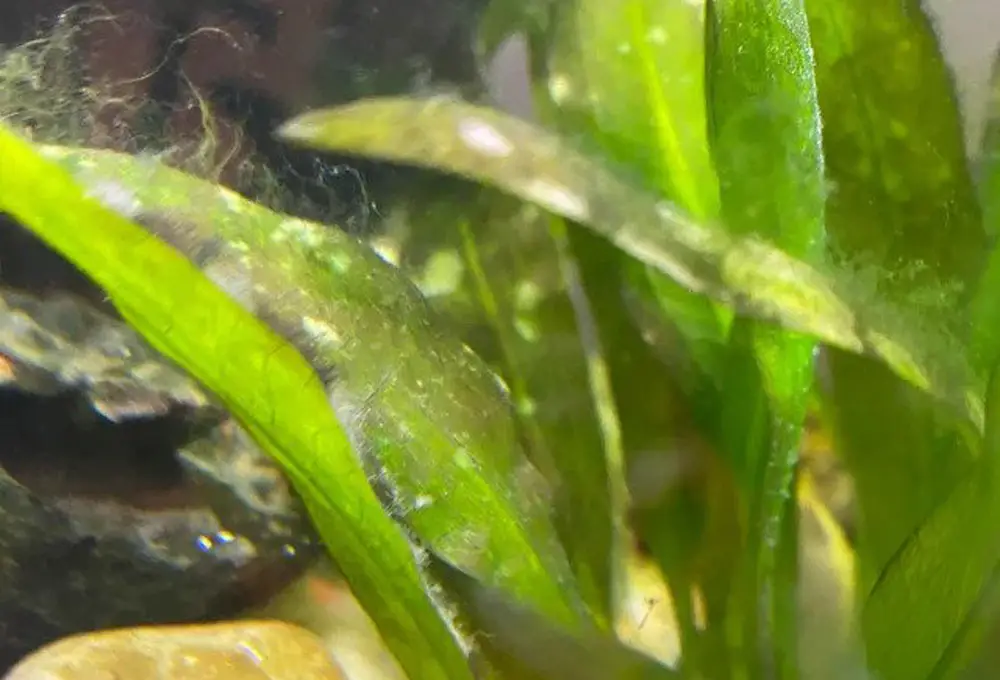
The term “white algae” is a misnomer and should not be used. The term “white algae” is often mistaken for a number of different types of white fuzzy growths or used to describe some filamentous Algae, such as Fuzz algae or Staghorn algae.
White algae make the fish tank look dirty, unclear, and slightly foggy, but it actually doesn’t have a direct negative impact on aquarium inhabitants. They are entirely harmless to fish, plants, and other invertebrates.
What Causes White Algae in Fish Tank?
White algae (fuzz or Staghorn Algae) blooms if the environment is ideal in supporting its growth. Here are some of the possible reasons why a fish tank may have excess amounts of white algae. This list doesn’t cover all potential causes but will help identify the most likely reasons for “white algae” growth.
- Uncycled aquarium: The main cause of white algae is an ammonia spike caused by an uncycled aquarium. Ammonia is produced by fish waste, uneaten food, and plant matter. The beneficial bacteria in the filter convert ammonia into nitrites and then into nitrates.
- Low oxygen level: Low oxygen levels can be caused by overcrowding, high water temperature, poor filtration, overfeeding, or weak surface agitation. White algae use the oxygen in the water, converting it back into carbon dioxide.
- Organic build-up: Many fish keepers overfeed their fish and other aquatic pets. Overfeeding your aquarium pets can lead to the growth of white algae. This will contribute to organic build-up that can give rise to white algae growth in the water.
- Too much light: If your aquarium has too much light for the whole day, it can promote white algae growth. Placing an aquarium away from the window is a great way to prevent direct sunlight that could affect algae growth. Generally, nine hours of light is enough for a tank.
- Overcrowded fish tank: When there is not enough space for each fish, they will compete for food and oxygen. This can lead to decreased oxygen levels and increased algae growth.
How do you get rid of white algae in a fish tank?
There are a few ways you can remove “white algae” from your fish tank. You can manually remove the growths with a toothbrush or use an aquarium scraper. Some people have had success using a razor blade to scrape off.
Keeping algae eaters in your fish tank is a great way to remove “white algae” invasions. It also keeps your tank clean and adds more life to your tank. The best algae eaters include Siamese algae eaters, bristlenose pleco, Amano shrimp, and nerite snail.
Final Thoughts
Maintaining a freshwater aquarium is both challenging and rewarding. As a responsible fish keeper, you should always strive to provide your fish with a clean living environment.
Dealing with white fuzz is relatively simple, as described above. Make sure to clean your aquarium properly and regularly test the water for harmful chemicals.
Did you enjoy our guide to white fuzz (fungus) vs. white algae and how to get rid of it? Did you find this article helpful? If you did, please share!
